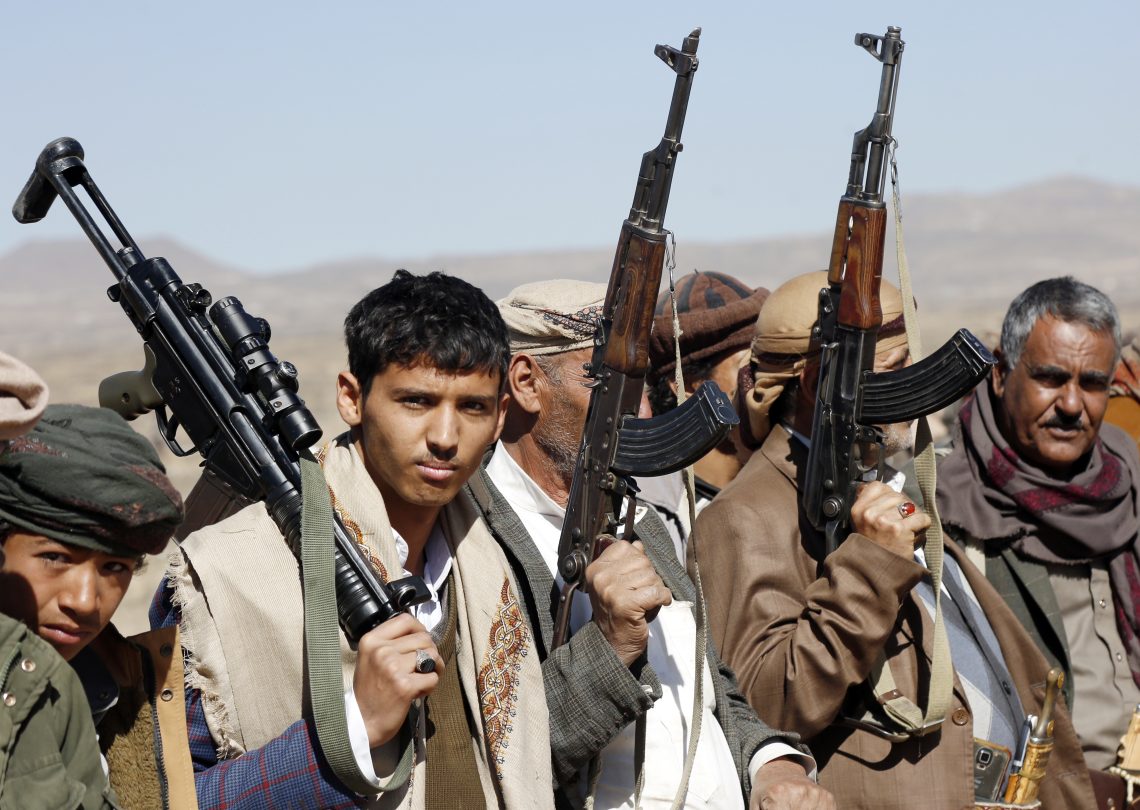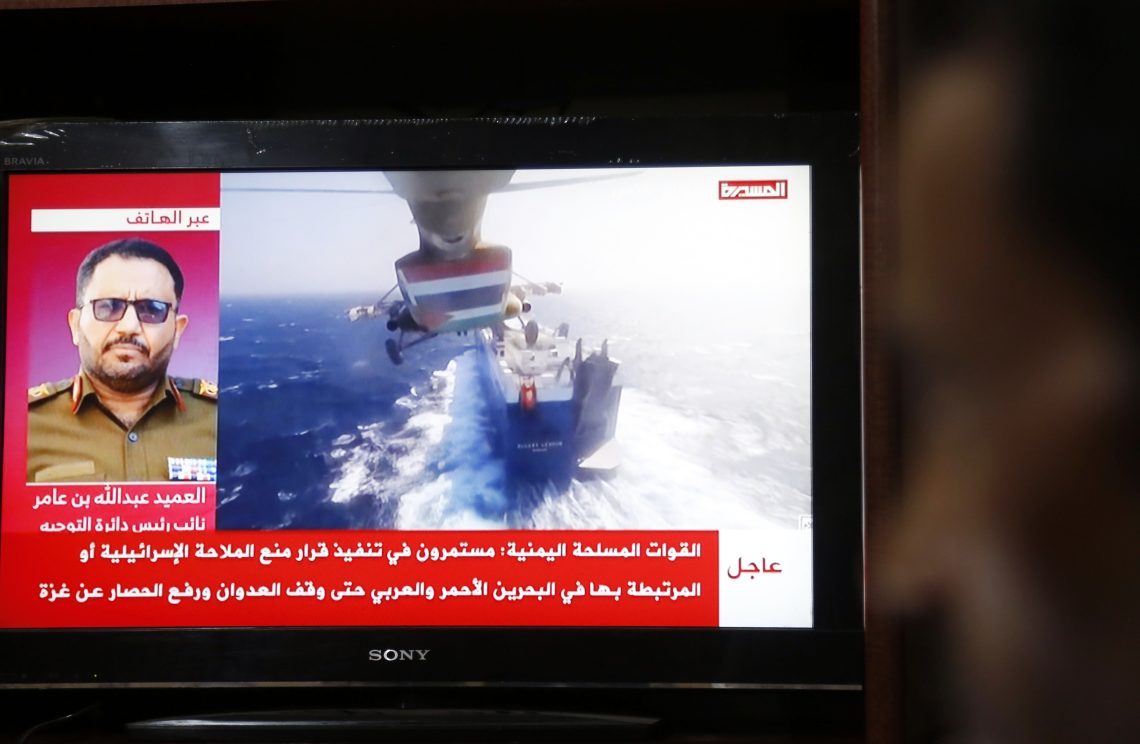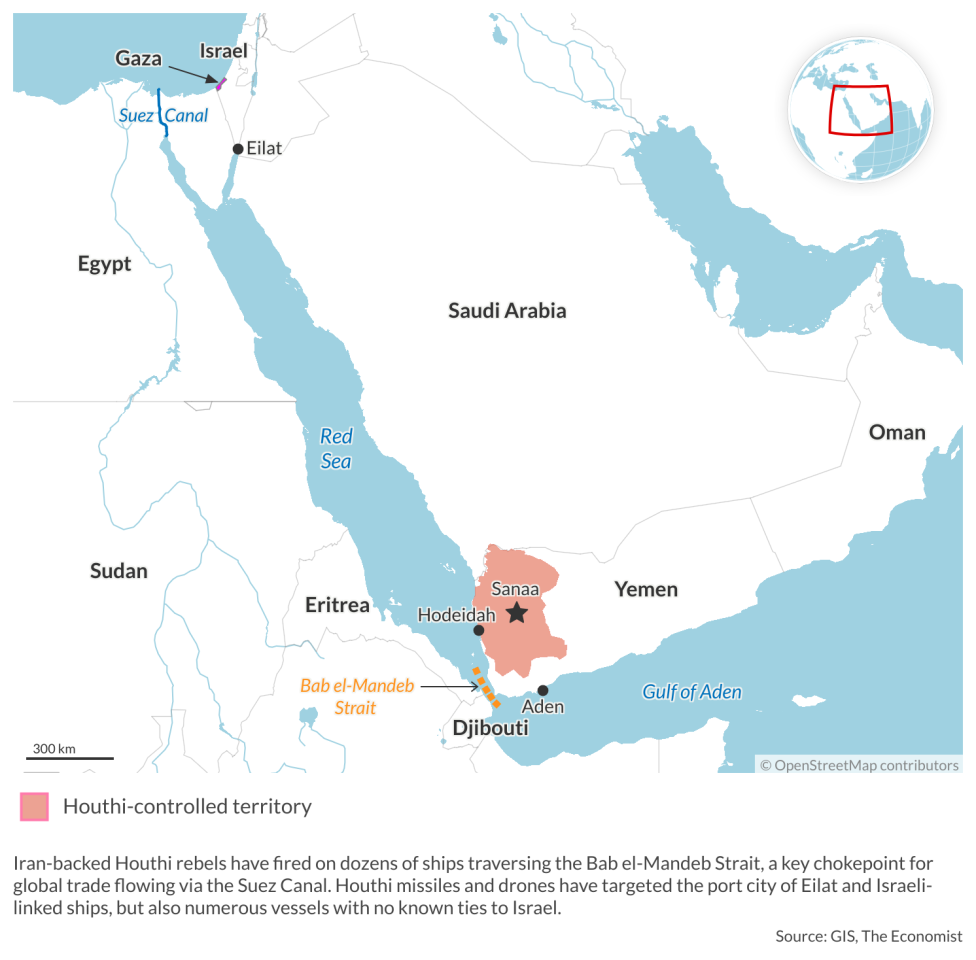Iran’s ‘axis of resistance’ after October 7, Part 2: The Houthis
The Houthi militants in Yemen have given Iran a useful tool to raise the temperature on both Israel and the United States from afar.

In a nutshell
- Iran has used the Houthis to pressure Israel without direct involvement
- Attacks on global shipping targets have begun to backfire
- The U.S. is unlikely to mount a comprehensive assault on the Houthis
This report is the second in a two-part series on Iran-backed militant groups amid the Israel-Hamas war. The first, on Hezbollah in Lebanon, is available here.
The recent retaliatory strikes by the United States and allies against Houthi militants in Yemen have stoked fears that the three-month-old war between Hamas and Israel will spread. As just one node in Iran’s network of proxy militias spread across the region, this tribal Yemeni rebel group has managed to disrupt international trade and threatens to draw the U.S. and possibly the United Kingdom into a Middle Eastern war.
The Houthi movement, which prefers to be called by its official name, Ansar Allah (“Supporters of God”), was created in 1992 by Hussein Badreddin al-Houthi. He was one of the leaders of his Houthi tribe, part of the Zaydi population of Yemen (later North Yemen), a branch of Shia Islam. Today the movement’s leader is his brother, Abdul-Malik Badreddin al-Houthi, also known as Abu Jibril.
The group started off as a political-educational movement inspired by Lebanon’s Hezbollah. Its slogan, also emblazoned on its flag, reads: “God Is the Greatest, Death to America, Death to Israel, A Curse Upon the Jews, Victory to Islam.” By 2014 the Houthis had managed to occupy the city of Sanaa. Until a United Nations-brokered cease-fire took effect in April 2022, they were fighting against Yemen’s legitimate government, which withdrew to the south, and against Saudi Arabia and the United Arab Emirates.
Ideological roots
The Zaydi Shia differ from the mainstream Shia of Iran, Iraq and Lebanon. While most Shia are “Twelvers” – namely, believers in 12 omniscient, God-inspired imams – the Zaydis are “Fivers,” holding that there are only five such imams. The first four are revered by all Shia, but Zaydis believe in a different Fifth Imam, Zayd ibn Ali, and are therefore called “Zaydiyya.” In their doctrine, the line of imams never ended, but those who came after the Fifth Imam were merely admired rulers, neither omniscient nor divinely inspired.
The Zaydi imams ruled Yemen for almost 1,000 years, including for some time as vassals of the Ottoman Empire. The last Zaydi imam was deposed in 1962 by an Egyptian-backed army colonel, Abdullah al-Sallal. From then on, North Yemen was ruled by military officers. It came under the control of General Ali Abdullah Saleh in 1978. North Yemen and South Yemen were united in 1990 under the influence and financial support of Iraq’s Saddam Hussein. But in 2011, amid the Arab Spring, the Houthis launched their revolt; three years later, they occupied the capital of Sanaa. The internationally recognized Yemeni government moved south, and the country was once again divided.
The attitude of Twelver Shia toward the Fivers can be somewhat disparaging – believing that, as this author was once told, “anyone who cannot count to twelve cannot be very bright.” Yet there remains an affinity between the two Shia sects. In fact, politically, the activism of the Islamic Republic of Iran is closer to the Zaydis than to the “Quietist” tradition of most historical Twelver Imams. Unlike the Fifth Imam of the Twelvers, who did not encourage his followers to revolt against Sunni rule, Zayd bin Ali, the Fifth Zaydi Imam, was a courageous revolutionary and died in battle.
Read more on Iran-backed militants
Iran’s ‘axis of resistance’ after October 7, Part 1: Hezbollah
Iranian support
For Iran, supporting the Houthis is both convenient and highly beneficial. As a proxy, the Houthis give Tehran access to the Red Sea and the Suez Canal – an enormously strategic asset. Their economy and military depend entirely on Iranian support. Because the Houthis are not exactly the embodiment of discipline, Iran’s Islamic Revolutionary Guard Corps (IRGC) has stationed missile and drone trainers and operators in Yemen, as well as personnel providing them with tactical intelligence support.
On October 31, over three weeks after the beginning of the Israel-Hamas war, a Houthi spokesman announced that the group had launched a “large number” of ballistic missiles and drones toward the Jewish state. Israel reported that it destroyed an unidentified “aerial target” over the Red Sea. Ever since, the Houthis have continued to launch missiles and drones against the southern Israeli city of Eilat. All of them were intercepted by Israel and the U.S. Navy.
On November 19, Yemeni forces highjacked the Nippon Yusen-operated, British-owned vessel “Galaxy Leader.” It was flying the flag of the Bahamas, transporting automobiles between India and Turkey, and its crew included no Israelis. But the Yemenis defined it as “Israeli” – since another company behind the ship is partly owned by an Israeli tycoon – and, as such, a legitimate target. The Houthis warned that all ships associated with Israel would become targets. Their spokesman warned the international community to avoid working with ships owned by Israeli individuals or carrying cargo to Israel “until the aggression against Gaza stops.”
This attack was followed by many others, although most ships attacked had no clear connection to Israel. By early December, most maritime traffic destined for the Red Sea was rerouted to the much longer route around Africa. This traffic is enormous: some 12 percent of global marine trade traverses the route from the Bab el-Mandeb Strait to the Suez Canal, and it takes about two to three weeks longer to use the African route instead.
Facts & figures
On December 18, U.S. Defense Secretary Lloyd Austin announced the establishment of “Operation Prosperity Guardian,” a collective action to protect civilian ships in the Red Sea. The only Arab country that joined this force was Bahrain. The Saudis, Emiratis and Egyptians remained in the background, reluctant to appear as if they are supporting the Israeli war in Gaza. Still, without a Saudi nod of approval, Bahrain would not have joined.
By mid-December, the Houthis had launched at least 100 drone and ballistic missile attacks, targeting 10 merchant vessels representing more than 35 different nations. Though it was somewhat slow to launch, the U.S.-led force has been effective. On December 31, for example, the U.S. Navy destroyed three of the four Houthi boats that attempted to hijack the Maersk Hangzhou, a Danish cargo ship, some 50 kilometers southwest of the Yemeni port of Hodeidah.
Since mid-January, having realized that international shipping would remain vulnerable as long as they only operated defensively, the American and British Navies launched several attacks on relevant Yemeni military installations. But the U.S. experiences in Afghanistan and Iraq and the fear of triggering a much wider confrontation may explain the American reluctance to launch a land invasion. The Houthis and Iran understand this, and therefore believe that they can continue this game until the Israel-Hamas war is over. To avoid a crisis with Iran’s allies, on January 19 the Houthis promised safe passage for Chinese, Russian and certain other ships, while excluding vessels “in any way connected with Israel.” This is a very broad definition.
Between 2014 and 2022, a Saudi-Emirati coalition failed in its fight against the Houthis. The reason was simple military incompetence, but it gave the rebel group an aura of unbeatable resilience. If “Operation Prosperity Guardian” is not used to destroy North Yemen’s military-related harbors, airports and other installations – ideally, even to end their rule – it will be unable to fully reopen the Red Sea route.
Threats to Israel
From Israel’s point of view, in the long run the status quo is unacceptable. The port of Eilat has been paralyzed since the end of November. Some 95 percent of Israel’s imports are based on shipping, accounting for around four million containers annually, 30 percent of which comes from the east through the Red Sea. Although urgent cargos are already coming from the east on trucks through Saudi Arabia and Jordan, the closure of the Red Sea is threatening to deal a major blow to Israel’s economy.
But there are more serious threats. Many shipping companies may decide to no longer ship Israeli cargo or visit any Israeli port for fear that their ships will be hijacked when they go through the Red Sea, even if they are not carrying goods destined for Israel. Appearing in the Houthis’ sights anywhere in the world may become bad for business. Any companies still willing to carry goods to Israel from East or Southeast Asia will have to extend their journey around Africa, costing the Israeli consumer a great deal.

In addition to economic fallout, there is already strategic damage to Israel’s image as a regional superpower. In 1967, after the British Prime Minister Harold Wilson (1964-70, 1974-1976) failed to assemble an international flotilla to open the Straits of Tiran, Israel launched the Six Day War against neighboring Egypt to open the passage. Despite the distance of some 2,000 kilometers between Jerusalem and Sanaa, sooner or later, if the international community does not open the Red Sea, Israel is very likely to act again.
The immediate reason why Iran has encouraged the Houthis to block the shipping rout is to bring international pressure to bear on Israel to end the war. For as long as it does not directly join the fray, every day of the war is an embarrassment for Tehran. In the meantime, the Houthis serve as an alibi. Isolating Israel in international trade is also a worthy goal. As a byproduct, without getting involved directly in the war, Iran can demonstrate its global reach and pressure points in case the U.S. or Israel are contemplating a preemptive attack on its nuclear program.
Unintended consequences
It seems, however, that Tehran has made a mistake. Rather than targeting only Israel-bound ships, the Houthis have also been attacking unrelated vessels. In addition to Israeli and Egyptian ships (and even if they spare Russian and Chinese ones), these kinds of wild-cat attacks will affect Europe and Japan, and even other Chinese interests in the Suez Canal. Even specifying “Israeli-owned” ships is too broad, because of the complicated ownership system in international shipping.
Ironically, among those hit hardest are Lebanese, mainly the Shia farmers of the south (a Hezbollah stronghold). A Lebanese official reported that “agricultural exports stopped completely” and that farmers must pay for cold storage, according to an Alhurra report. Lebanon exports about 400,000 tons of agricultural products annually, worth close to $1 billion, mostly to the Gulf Arab states. And it imports over $2.5 billion of goods from China, including 14 percent of its food imports. Almost all this trade has travelled via the Red Sea since the land route through Saudi Arabia was blocked in 2021, after Saudi customs seized millions of Captagon amphetamine pills smuggled in boxes of pomegranates.
The problem has become an international one. Publicly, Iran is openly praising the Houthis. Top national security official Ali Akbar Ahmadian, for example, recently praised Houthi support for the Palestinians against Israel. But in private, Tehran is surely re-examining its strategy. Now that an international flotilla is active, if the regime does not order the Houthis to limit their attacks to Israel-bound ships, it risks an escalated Western retaliation, including attacks further into Yemeni territory. If they do choose to limit the Houthis to Israel-bound ships, geographical distance notwithstanding Israel will have a freer hand.
Scenarios
More likely: Continued attacks
The more likely scenario is that, until it decides that the Gaza war is over, Tehran will stay its course. The Houthis will continue their attacks, at least against Israeli-bound, American and British ships. Tehran views this as the best way to bring U.S. pressure on Israel to stop the war.
The weak American response to past Iranian attacks on U.S. and Gulf Arab targets has convinced Tehran that the Americans will not go all the way. Washington will continue, though, to try from sea and air to degrade the Houthis’ ability to interfere with freedom of navigation. In the unlikely event that the U.S. goes for the Houthi jugular, Iran will settle for covertly supporting the rebels’ guerilla warfare.
Less likely: Restraint
The less likely scenario is that Iran will limit the Houthis to attacking only Israeli-bound ships. Left on its own, within a few months Israel is likely to attack, to convince the Houthis that their piracy bears too great a cost. In such a case, Iran may support the Houthis directly.
For industry-specific scenarios and bespoke geopolitical intelligence, contact us and we will provide you with more information about our advisory services.









